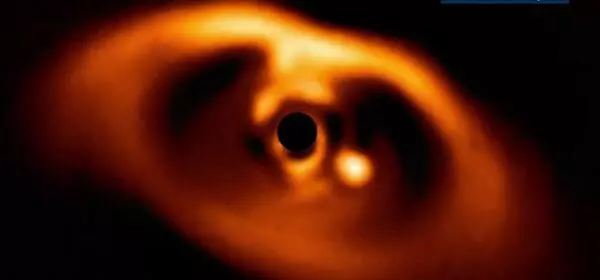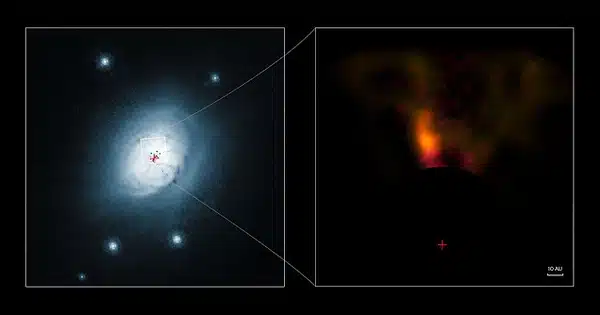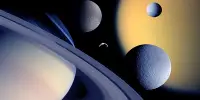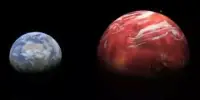Planet formation research and the finding of fresh knowledge about it is an intriguing area of astronomy and astrophysics. Researchers collect data and photos from numerous tools and instruments, such as telescopes and space missions, to better understand how planets develop in protoplanetary disks around young stars.
Astronomers have discovered new information on how giant planets like Jupiter develop. Large dusty clumps have been discovered near a young star, which could collapse to become huge planets.
A stunning new image released today by the European Southern Observatory hints at how planets as large as Jupiter might develop. Researchers have discovered enormous dusty clumps close to a young star using ESO’s Very Enormous Telescope (VLT) and the Atacama Large Millimeter/submillimeter Array (ALMA), which could collapse to become gigantic planets.
“This discovery is truly captivating because it marks the first detection of clumps around a young star that have the potential to give rise to giant planets,” says Alice Zurlo, a researcher at Chile’s Universidad Diego Portales who was part in the observations.
This discovery is truly captivating because it marks the first detection of clumps around a young star that have the potential to give rise to giant planets.
Alice Zurlo
The work is based on a stunning image produced with ESO’s VLT’s Spectro-Polarimetric High-contrast Exoplanet REsearch (SPHERE) instrument, which shows remarkable detail of the material surrounding the star V960 Mon. This young star, located almost 5,000 light-years away in the constellation Monoceros, drew astronomers’ attention in 2014 when its brightness unexpectedly surged more than twenty times. SPHERE measurements conducted shortly after the commencement of this brightness ‘outburst’ revealed that the material around V960 Mon is forming in a series of complicated spiral arms spanning distances greater than the whole Solar System.
This discovery prompted astronomers to examine archive images of the same system acquired with ALMA, a collaboration in which ESO is a partner. The VLT observations look at the surface of the dusty material surrounding the star, whereas ALMA can look deeper into its structure. “With ALMA, it became apparent that the spiral arms are undergoing fragmentation, resulting in the formation of clumps with masses akin to those of planets,” Zurlo explains.

Astronomers believe that huge planets develop by ‘core accretion,’ which occurs when dust grains collide, or through ‘gravitational instability,’ which occurs when large chunks of the material surrounding a star compress and collapse. While evidence for the first of these scenarios has previously been discovered, evidence for the latter has been scarce.
“No one had ever seen a real observation of gravitational instability happening at planetary scales – until now,” says Philipp Weber, a researcher at Chile’s University of Santiago who led the study, which was published today in The Astrophysical Journal Letters.
“Our group has been searching for signs of how planets form for over ten years, and we couldn’t be more thrilled about this incredible discovery,” team member Sebastián Pérez of the University of Santiago, Chile, said.
ESO instruments will aid scientists in uncovering more facts about this fascinating planetary system in the making, with the Extremely Large Telescope (ELT) playing a major role. The ELT, which is now being built in Chile’s Atacama Desert, will be able to observe the system in greater detail than ever before, collecting critical information about it. “The ELT will enable the exploration of the chemical complexity surrounding these clumps, helping us find out more about the composition of the material from which potential planets are forming,” Weber concludes.
















